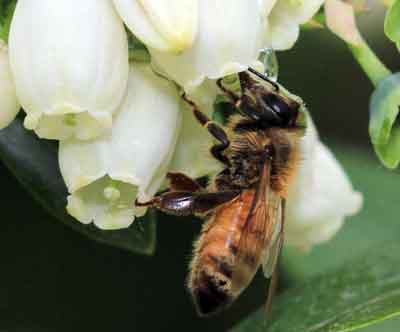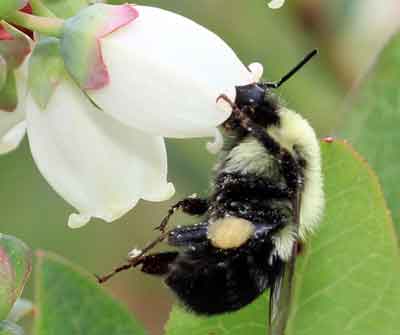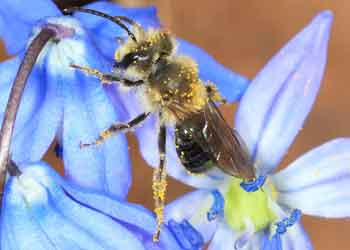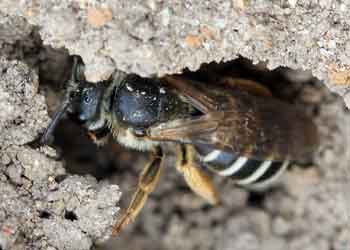Invest in pollination for success with highbush blueberries
For profitable yields, investing in pollination of highbush blueberries is crucial.

Northern highbush blueberries (Vaccinium corymbosum) are common throughout the northern United States and Canada, and are native to eastern North America. They require pollination to ensure that flowers present at bloom turn into large, harvestable berries later in the season. Pollination is achieved by the movement of pollen by bees.
By planning ahead for how fields will be pollinated, growers can help ensure they receive the maximum return on their investments in land, bushes and other management inputs. Given the high per-acre input costs of blueberry production, spending money to ensure high levels of pollination makes sound business sense. Other things being equal, well-pollinated fields have larger berries, higher yields, and more even ripening than fields with sub-optimal pollination.
Across Michigan’s blueberry industry, most pollination is by managed honey bees that are brought to fields in hives. Many of these colonies have been overwintered in warmer states and they arrive back in Michigan as fruit crops start blooming in Southwest Michigan. Bumble bee colonies can also be purchased for placement in fields and there are many other wild bee species that nest in and around crop fields. By combining these pollinators into an integrated crop pollination strategy, the risk of poor pollination may be minimized.
Pollen is moved by bees
For pollination to occur, sufficient compatible blueberry pollen must be moved from the male part of flowers (anthers) to the female part (stigma) while the flowers are receptive. Bees are responsible for this movement of pollen, so blueberry pollination depends on having enough bees active in the field during bloom to deliver pollen. Each flower must be visited once by a bumble bee or most native bees, or three times by honey bees to get enough pollen so that berries will grow to maximum size. There can be 10 million flowers per acre, so there is a lot of work for bees to do!
The pollen produced by blueberry flowers is relatively heavy and doesn’t waft on the wind. It is held inside the flower by salt shaker-like structures called anthers until bees visit. They may release the pollen by jiggling the flower with their legs, as is the case for honey bees. Bumble bees and some other native bees are better adapted to release the pollen using a vibration behavior known as “buzz pollination.” When the bees shake the anthers, the pollen collects on their bodies. As the bees move from flower to flower, pollen grains are transferred to the stigma. Flowers are receptive to pollen immediately on opening, and their chance of turning into a berry declines after three days with flowers unlikely to turn into fruit after five to six days. Once compatible pollen is deposited on the stigma, the pollen germinates and fertilizes the ovules that produce the tiny seeds. Fertilized seeds release hormones that stimulate berry growth, leading to larger berries.
Things to know before planting
Northern highbush blueberry bushes can produce berries even when there is no or limited pollen deposition by bees. This means that some proportion of the flowers can turn into berries, even if there are poor pollination conditions or low bee activity during bloom. However, these berries will be small, slow to ripen, may drop off early, and most would not be considered marketable (Photo 1, left). To reach maximum potential yield, it is important that the flowers are visited by bees during bloom to transfer sufficient pollen to the stigma while the flower is still viable so that fertilization can occur, leading to seed set, berry expansion, and larger berries (Photo 1, right). If designing a blueberry field of any appreciable size over a few acres, make sure there will be space for a beekeeper to drop hives on pallets near the field.
For some cultivars, it is not sufficient just to get high rates of pollen transfer from bees because the type of pollen can be important. Some cultivars benefit from the transfer of cross-compatible pollen, meaning that the field should be designed to have a combination of cultivars that bloom around the same time and that are compatible. For cultivars dependent on having cross-pollination for full yields, this can provide a 10-20 percent increase in yield from the improved fruit set and berry size. Table 1 provides a guide to cultivars and their level of dependence on this cross pollination for full yields. However, many popular northern highbush blueberry cultivars are self-fruitful, meaning they can be fertilized by pollen from the same cultivar (High group in the table), and this is one reason why solid blocks of some cultivars can be highly productive. Other cultivars are intermediate, meaning that a benefit can be gained by interplanting with another cultivar, but for many commercial settings growers might consider the increased complications in management outweigh the benefits.
|
Table 1. Variation among highbush blueberry cultivars in the need for a pollinizing cultivar to provide cross-compatible pollen during bloom | |
|---|---|
|
Dependence on a pollinizing cultivar |
Cultivar |
|
Low: no pollinizer needed |
Duke, Draper, Bluejay, Nelson and Rubel |
|
Intermediate: pollinizer beneficial |
Bluecrop, Legacy, Jersey, Liberty, Elliott and Aurora |
|
High: pollinizer needed |
Brigitta, Spartan, Chippewa, Polaris and Toro |
In a third group, cross-pollination is needed, and this is achieved by bees moving pollen between cultivars as they fly from row to row. In this situation, planting fields with alternating blocks of co-blooming and compatible cultivars ensures cross-pollination. While alternate rows of two compatible cultivars would be the best for pollination, it would also cause difficulties with harvesting and spraying. Alternating blocks of up to eight rows allows pollen exchange and is easier to manage. Alternating blocks of larger sizes will result in too few exchanges between cultivars that need cross-pollination. Before purchasing blueberry plants, check with your nursery to determine the need for planting fields with alternating cultivars.
Using honey bees for blueberry pollination
Wait until bloom has started to bring in bees
Flowers of blueberries are generally less attractive to honey bees than other flowers due to the relatively low nectar reward. Because of this, it is best to bring in bees once the crop has started to bloom so that bees forage more on blueberries than other flowers (Photo 2). If brought in too early, bees may learn to forage elsewhere, reducing their focus on your crop fields. Move bees into blueberry fields after 5 percent bloom, but before 25 percent of full bloom. Placement near to the blueberry field can also help to keep them focused on the crop. Still, some cultivars, notably Jersey, have low attractiveness, and bees may still fly over this cultivar to reach another.

Photo 2. A honey bee drinking nectar from a blueberry flower. This is the workhorse of blueberry pollination, and to achieve high yields the fields must be stocked with sufficient numbers of healthy colonies during bloom to ensure there are enough bees for sufficient transfer of pollen between flowers. Photo credit: Jason Gibbs, MSU
Renting healthy colonies
If you are renting honey bee hives, you should expect to receive healthy and vigorous bees. A healthy colony contains around 30,000 worker honey bees and will have six frames of brood. Having weak hives will affect how much pollination the fields receive, so it is worth taking time to ensure you have strong hives. If you suspect weak colonies, talk to your beekeeper about getting additional hives or replacing them. One strong hive of 30,000 bees will provide better pollination than two 15,000 bee hives because there will be more worker bees that fly to visit flowers. One way for growers to ensure they receive strong colonies is to establish a pollination agreement that lays out the grower’s expectations. This can include the strength of the colonies and how quickly the colonies will be taken out of the field after bloom. Example pollination contracts are available online.
Honey bee stocking densities
There have been many changes in blueberry production and in bees over the past few decades, and yet many people still refer to bee stocking recommendations published in 1992. We consider those to be suitable for fields with lower bloom density, such as in a field affected by frost or when it is still establishing, and these can also be used in small fields surrounded by natural lands that will have higher populations of wild bees. However, if fields have a high flower density as some of the newer cultivars and intensive production systems provide or if field sizes are large without wild habitat nearby, then these recommendations are too low.
The last few decades have also seen the loss of feral honey bee colonies due to the parasitic Varrroa mites, so those colonies are no longer contributing to blueberry pollination. All of these factors can make fruit production more dependent than ever on managed bees, so it is important to stock fields with sufficient bees to supply enough visits to flowers while they are most viable, such as in the first three days after opening.
A final point to make here is that if the weather is hot during bloom and flowers open quickly, this increases the chance that they will not get visited before they lose viability. Higher stocking densities can counteract this potential limiting factor.
Research and experience in blueberries has shown variation across northern highbush cultivars in their needs for bee pollination (Table 2) due to the relative attractiveness of different cultivars and their degree of self-compatibility. The table below shows a range of stocking densities from the lower rates recommended two decades ago to the updated double rate that Michigan State University Extension considers the required stocking density for fully productive modern fields. This shows five hives per acre for Jersey and Earliblue, but some growers are using up to eight colonies per acre to ensure good pollination if spring weather is cool and there are only a few good days for honey bee activity. These higher stocking densities can also be considered a form of pollination insurance to make sure that whatever the spring brings there will be the best chance of good pollination.
|
Table 2. Recommended stocking density of honey bees for highbush blueberry pollination. Cultivars have varying rates of need for honey bees, and within each group we show a range of hives per acre to stock at, ranging from low rates for use in young, frost-damaged, or small fields to high rates for use in mature, healthy, or large fields. | ||
|---|---|---|
|
Cultivar |
Honey bee hives per acre | |
|
Low rate |
High rate | |
|
Rubel, Rancocas |
0.5 |
1 |
|
Weymouth, Bluetta, Blueray |
1 |
2 |
|
Bluecrop |
1.5 |
3 |
|
Elliot, Coville, Berkeley, Stanley |
2 |
4 |
|
Jersey, Earliblue |
2.5 |
5 |
A rule of thumb is that you'll need four to eight honey bees per bush in the warmest part of the day during bloom to get blueberries pollinated. Also, if you see flowers turning brown and discolored on the bush, pollination was not sufficient; in well-pollinated fields, the corollas fall off when they are still bright white. Check your fields this season and if needed you can try to get additional hives from a beekeeper or plan on increased stocking next spring.
Hive placement
If possible, place the colonies in sheltered locations with the entrances facing east or south. This will encourage earlier activity as the hive warms in the morning sun. Hives should be spread out around the farm to maximize floral visitation with a maximum of 300 yards between hives. Placement in an open area slightly away from the edge of the fields also reduces the risk of pesticide drifting onto colonies being disturbed by a tractor.
Using bumble bee colonies
Bumble bees are very efficient at pollinating blueberries with activity at lower temperatures than honey bees, faster visits to flowers, and higher rates of pollen transfer per flower visit. A single visit of a bumble bee to a blueberry flower can deposit sufficient pollen to get full pollination, whereas three visits are needed by honey bees.
The common Eastern bumble bee, Bombus impatiens (Photo 3), has been reared for use as a crop pollinator. These insects are available commercially and can be shipped directly to the farm in eastern United States and Canada. Koppert is one supplier based in Michigan that provides the bees in Quads, each containing four colonies housed within a weather-proof box. Our evaluations with this species in commercial Jersey fields found they provided comparable yield and fruit set to honey bees when tested in small fields at the recommended stocking density of three colonies per acre.

Photo 3. Bumble bees are efficient pollinators of blueberry, so they should be encouraged on the farm. They can also be purchased from commercial suppliers and their colony boxes placed near fields to provide crop pollination. Photo credit: Jason Gibbs, MSU
Growers may also purchase bumble bees to integrate with honey bees, thereby diversifying pollination sources. This approach should help ensure movement of pollen between flowers during conditions that are unsuitable for honey bees. Rearing bumble bees takes time, so orders should be made 14-16 weeks in advance to guarantee delivery. Place Quads through the farm and well away from honey bee hives. A door on the box of the Quads can be used to collect the bees and move them before spraying.
Wild bee pollinators
While ants, butterflies and hover flies will visit blueberry flowers to gather nectar, bees are the most effective at moving pollen. Over 150 wild bee species have been found in Michigan blueberry fields, and about 10 of these were sufficiently abundant during bloom and carried enough pollen to be considered valuable crop pollinators. These bees do best in farms with flowers for them to visit outside the crop bloom period and in farms where there are some undisturbed areas for nesting (Photos 4-5), and farms can be managed to enhance their abundance.


Photos 4-5. Many wild bee species require flowers to visit when the crop is not in bloom and areas of undistubed soil for nesting. Left, a miner bee gathering pollen from an early spring flower. Right, a sweat bee searching for a place to nest in the soil. Photo credits: Jason Gibbs, MSU
Wild bees fall into several major categories, including bumble bees, miner bees, sweat bees, mason bees and carpenter bees. Bumble bees and some sweat bees form social colonies later in the summer, but in spring during blueberry bloom these bees are in a solitary phase. Miner bees, mason bees and carpenter bees are solitary: each nest is built by a single female. Miner bees are abundant during the spring, and some species, such as Andrena carolina, are specialists on blueberries.
Wild bees nest in different areas in and around blueberry fields. Miner bees and most sweat bees make underground nests. A female bee tunnels into the soil, preparing brood cells for her young on side branches from the main tunnel. Pollen and nectar is collected and shaped into a ball placed in each cell. A single egg is laid on each pollen ball that provides food for the developing larva. These bees need untilled soil and have been seen nesting underneath blueberry bushes in the weed-free strip. Thick layers of mulch can prevent ground nesting bees from digging tunnels.
Some bees also nest in the undisturbed soil in nearby woods. Bumble bees also need undisturbed soil to nest in abandoned rodent burrows or grass tussocks, but they will also use old mattresses, compost piles and other protected sites with small entrances. Finally, some wild bees such as carpenter bees, some sweat bees and mason bees, prefer to nest in twigs, dead wood or pre-existing cavities. Brambles, logs and tree stumps in adjacent habitat and fence rows can be useful nesting sites for these bees.
In small blueberry fields surrounded by natural habitat, wild bees can provide the majority of pollination. However, as blueberry farm size and intensity increase, the high abundance of flowers and the small amount of natural area results in too few native bees for full pollination, and so growers rent honey bees. Still, by creating bee habitat that includes a mix of plants that bloom before and after blueberries, growers can help support native bees as part of an integrated crop pollination strategy.
For more on native plants to support pollinators in the Great Lakes region, visit MSU’s Native Plants and Ecosystem Services website. Every little bit of habitat will help, so consider this a long-term process of building bee habitat back into the farm landscape. The Natural Resources Conservation Service (NRCS) can provide cost share for growers interested in establishing pollinator habitat in their farms. See your local NRCS office for details of programs that can support this.
Pest management during pollination
Most insecticides have some level of toxicity to bees, so there are restrictions on their use during bloom. Not spraying while honey bees are in the field is the most effective way to avoid any risk of poisoning, so monitoring for pest problems carefully before and during bloom can help minimize the need for pest control at this time of the season. However, insect outbreaks do occur and this time of the season is an important one for control of mummy berry. If a pesticide application is necessary during bloom, the compounds that are least toxic to bees should be used with careful observation of the pollinator restrictions on the label. Two insecticides that can be applied during bloom for control of moth larvae in blueberries are products containing Bacillus thuringensis (Bt), such as Dipel and Javelin, and the insect growth regulators Intrepid and Confirm.
The U.S. Environmental Protection Agency (EPA) has developed new pesticide labeling guidelines for certain insecticides that limit their use where honey bees are present. This information is gradually being added to the labels of some insecticides, including neonicotinoids and the new product Exirel. Since these pesticides have never been labeled for use during bloom in blueberries, this is not a significant change, but it provides more information. EPA’s infographic can be downloaded here: The New EPA Bee Advisory Box.
If spraying during the bloom period, one of the most important things growers can do to minimize effects on bees is to apply when the bees are not foraging. Late evening is the best time to apply sprays during bloom because the compounds have time to be absorbed and for the residues to dry before bees are active the following morning. Dust formulations must be avoided because particles can be picked up easily by the bees’ hairy bodies.
Recent research has also found that certain fungicides have effects on bees, harming their gut microbes and making them more susceptible to parasite infections. This can in turn result in reduced colony health and increased mortality. Follow the same basic principles of spraying only when necessary and when bees are not foraging to reduce the potential for harming bees during bloom.
More information and a list of pesticides with their toxicity to bees is available from a recently-updated MSU Extension bulletin, “Minimizing pesticide risk to bees in fruit crops” (E3245). This document contains a list of insecticides and fungicides ranked by their relative risk to bees and plenty of other good information on how to prevent bee poisoning.
Summary
Pollination is an essential component of growing blueberries. To attain high levels of fruit set with large, evenly-ripening berries requires bees to deposit enough pollen on stigmas during bloom. This can be done by honey bees, other managed bees and wild bees. As with pest management, reliance on one strategy may not be the most sustainable approach, so diversifying pollination sources can spread risk to ensure consistent pollination and profitable yields every year.
Whichever bees are visiting flowers during bloom, ensuring the health and safety of these insects is an important part of maintaining good pollination. Follow label restrictions and practice good pollinator stewardship so they can provide the all-important transfer of pollen that will lead to large berries and high yields.
Drs. Isaacs, Hanson and Hancock's work is funded in part by MSU’s AgBioResearch.



 Print
Print Email
Email



